PHYSICS 1: Radiation Physics Solutions Assignment - University Name
VerifiedAdded on 2020/05/08
|8
|1257
|146
Homework Assignment
AI Summary
This document provides comprehensive solutions to a Physics 1 assignment focused on radiation physics. The solutions cover a range of topics including the concepts of free air ionization chambers, equivalent and effective doses, stopping power and linear energy transfer, radioactive and biological half-lives, and deterministic and stochastic effects of radiation. It also includes detailed explanations and calculations related to absolute and relative dosimetry, the impact of Prussian blue treatment on effective half-life, and the application of the inverse square law. The assignment incorporates relevant formulas and calculations, providing a thorough understanding of the principles and applications of radiation physics. The document also references several academic papers that support the solutions provided. This assignment is contributed to Desklib, a platform providing AI-based study tools for students.

Running head: PHYSICS 1
Paraphrase This Document
Need a fresh take? Get an instant paraphrase of this document with our AI Paraphraser
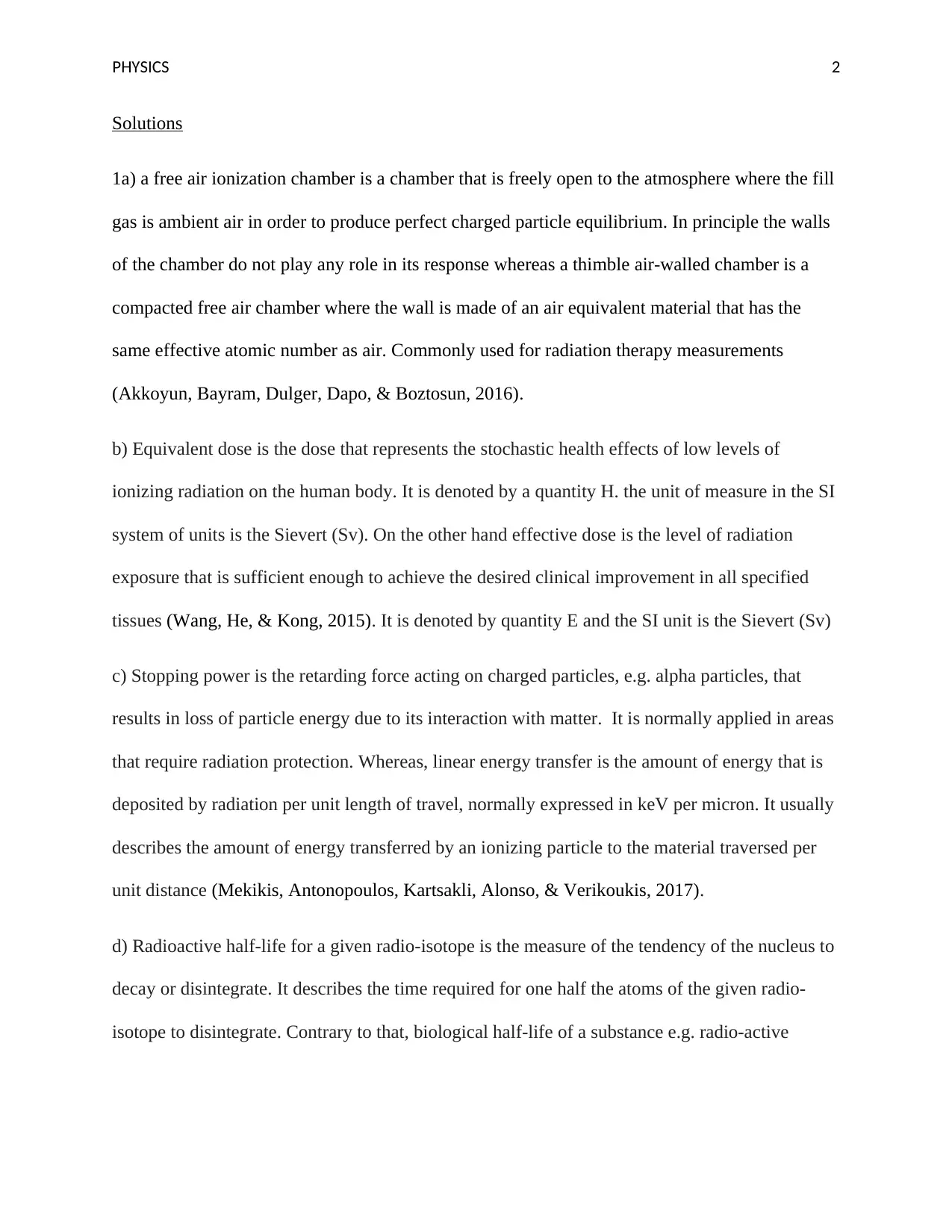
PHYSICS 2
Solutions
1a) a free air ionization chamber is a chamber that is freely open to the atmosphere where the fill
gas is ambient air in order to produce perfect charged particle equilibrium. In principle the walls
of the chamber do not play any role in its response whereas a thimble air-walled chamber is a
compacted free air chamber where the wall is made of an air equivalent material that has the
same effective atomic number as air. Commonly used for radiation therapy measurements
(Akkoyun, Bayram, Dulger, Dapo, & Boztosun, 2016).
b) Equivalent dose is the dose that represents the stochastic health effects of low levels of
ionizing radiation on the human body. It is denoted by a quantity H. the unit of measure in the SI
system of units is the Sievert (Sv). On the other hand effective dose is the level of radiation
exposure that is sufficient enough to achieve the desired clinical improvement in all specified
tissues (Wang, He, & Kong, 2015). It is denoted by quantity E and the SI unit is the Sievert (Sv)
c) Stopping power is the retarding force acting on charged particles, e.g. alpha particles, that
results in loss of particle energy due to its interaction with matter. It is normally applied in areas
that require radiation protection. Whereas, linear energy transfer is the amount of energy that is
deposited by radiation per unit length of travel, normally expressed in keV per micron. It usually
describes the amount of energy transferred by an ionizing particle to the material traversed per
unit distance (Mekikis, Antonopoulos, Kartsakli, Alonso, & Verikoukis, 2017).
d) Radioactive half-life for a given radio-isotope is the measure of the tendency of the nucleus to
decay or disintegrate. It describes the time required for one half the atoms of the given radio-
isotope to disintegrate. Contrary to that, biological half-life of a substance e.g. radio-active
Solutions
1a) a free air ionization chamber is a chamber that is freely open to the atmosphere where the fill
gas is ambient air in order to produce perfect charged particle equilibrium. In principle the walls
of the chamber do not play any role in its response whereas a thimble air-walled chamber is a
compacted free air chamber where the wall is made of an air equivalent material that has the
same effective atomic number as air. Commonly used for radiation therapy measurements
(Akkoyun, Bayram, Dulger, Dapo, & Boztosun, 2016).
b) Equivalent dose is the dose that represents the stochastic health effects of low levels of
ionizing radiation on the human body. It is denoted by a quantity H. the unit of measure in the SI
system of units is the Sievert (Sv). On the other hand effective dose is the level of radiation
exposure that is sufficient enough to achieve the desired clinical improvement in all specified
tissues (Wang, He, & Kong, 2015). It is denoted by quantity E and the SI unit is the Sievert (Sv)
c) Stopping power is the retarding force acting on charged particles, e.g. alpha particles, that
results in loss of particle energy due to its interaction with matter. It is normally applied in areas
that require radiation protection. Whereas, linear energy transfer is the amount of energy that is
deposited by radiation per unit length of travel, normally expressed in keV per micron. It usually
describes the amount of energy transferred by an ionizing particle to the material traversed per
unit distance (Mekikis, Antonopoulos, Kartsakli, Alonso, & Verikoukis, 2017).
d) Radioactive half-life for a given radio-isotope is the measure of the tendency of the nucleus to
decay or disintegrate. It describes the time required for one half the atoms of the given radio-
isotope to disintegrate. Contrary to that, biological half-life of a substance e.g. radio-active
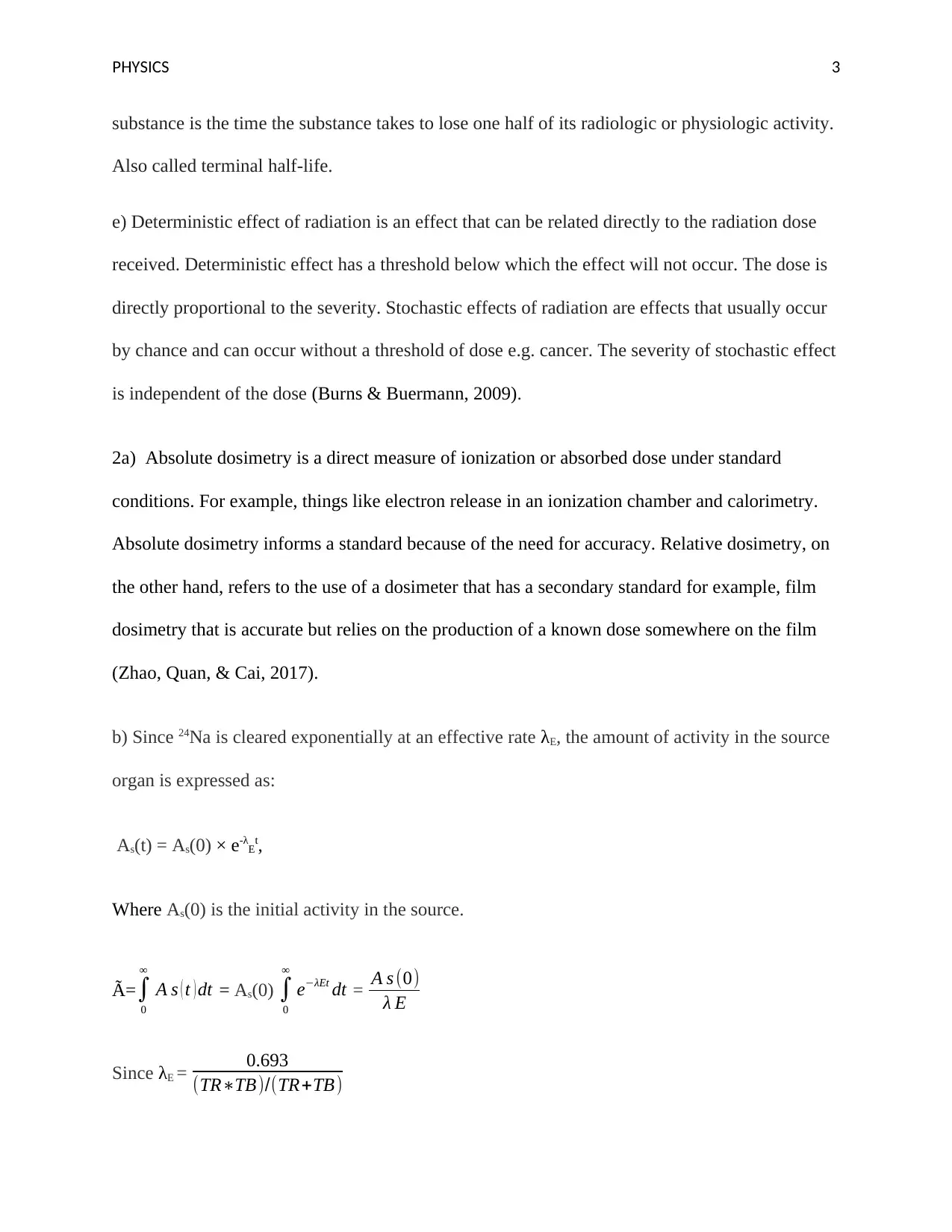
PHYSICS 3
substance is the time the substance takes to lose one half of its radiologic or physiologic activity.
Also called terminal half-life.
e) Deterministic effect of radiation is an effect that can be related directly to the radiation dose
received. Deterministic effect has a threshold below which the effect will not occur. The dose is
directly proportional to the severity. Stochastic effects of radiation are effects that usually occur
by chance and can occur without a threshold of dose e.g. cancer. The severity of stochastic effect
is independent of the dose (Burns & Buermann, 2009).
2a) Absolute dosimetry is a direct measure of ionization or absorbed dose under standard
conditions. For example, things like electron release in an ionization chamber and calorimetry.
Absolute dosimetry informs a standard because of the need for accuracy. Relative dosimetry, on
the other hand, refers to the use of a dosimeter that has a secondary standard for example, film
dosimetry that is accurate but relies on the production of a known dose somewhere on the film
(Zhao, Quan, & Cai, 2017).
b) Since 24Na is cleared exponentially at an effective rate λE, the amount of activity in the source
organ is expressed as:
As(t) = As(0) × e-λEt,
Where As(0) is the initial activity in the source.
Ã= ∫
0
∞
A s ( t ) dt = As(0) ∫
0
∞
e−λEt dt = A s (0)
λ E
Since λE = 0.693
(TR∗TB)/(TR+TB)
substance is the time the substance takes to lose one half of its radiologic or physiologic activity.
Also called terminal half-life.
e) Deterministic effect of radiation is an effect that can be related directly to the radiation dose
received. Deterministic effect has a threshold below which the effect will not occur. The dose is
directly proportional to the severity. Stochastic effects of radiation are effects that usually occur
by chance and can occur without a threshold of dose e.g. cancer. The severity of stochastic effect
is independent of the dose (Burns & Buermann, 2009).
2a) Absolute dosimetry is a direct measure of ionization or absorbed dose under standard
conditions. For example, things like electron release in an ionization chamber and calorimetry.
Absolute dosimetry informs a standard because of the need for accuracy. Relative dosimetry, on
the other hand, refers to the use of a dosimeter that has a secondary standard for example, film
dosimetry that is accurate but relies on the production of a known dose somewhere on the film
(Zhao, Quan, & Cai, 2017).
b) Since 24Na is cleared exponentially at an effective rate λE, the amount of activity in the source
organ is expressed as:
As(t) = As(0) × e-λEt,
Where As(0) is the initial activity in the source.
Ã= ∫
0
∞
A s ( t ) dt = As(0) ∫
0
∞
e−λEt dt = A s (0)
λ E
Since λE = 0.693
(TR∗TB)/(TR+TB)
⊘ This is a preview!⊘
Do you want full access?
Subscribe today to unlock all pages.

Trusted by 1+ million students worldwide
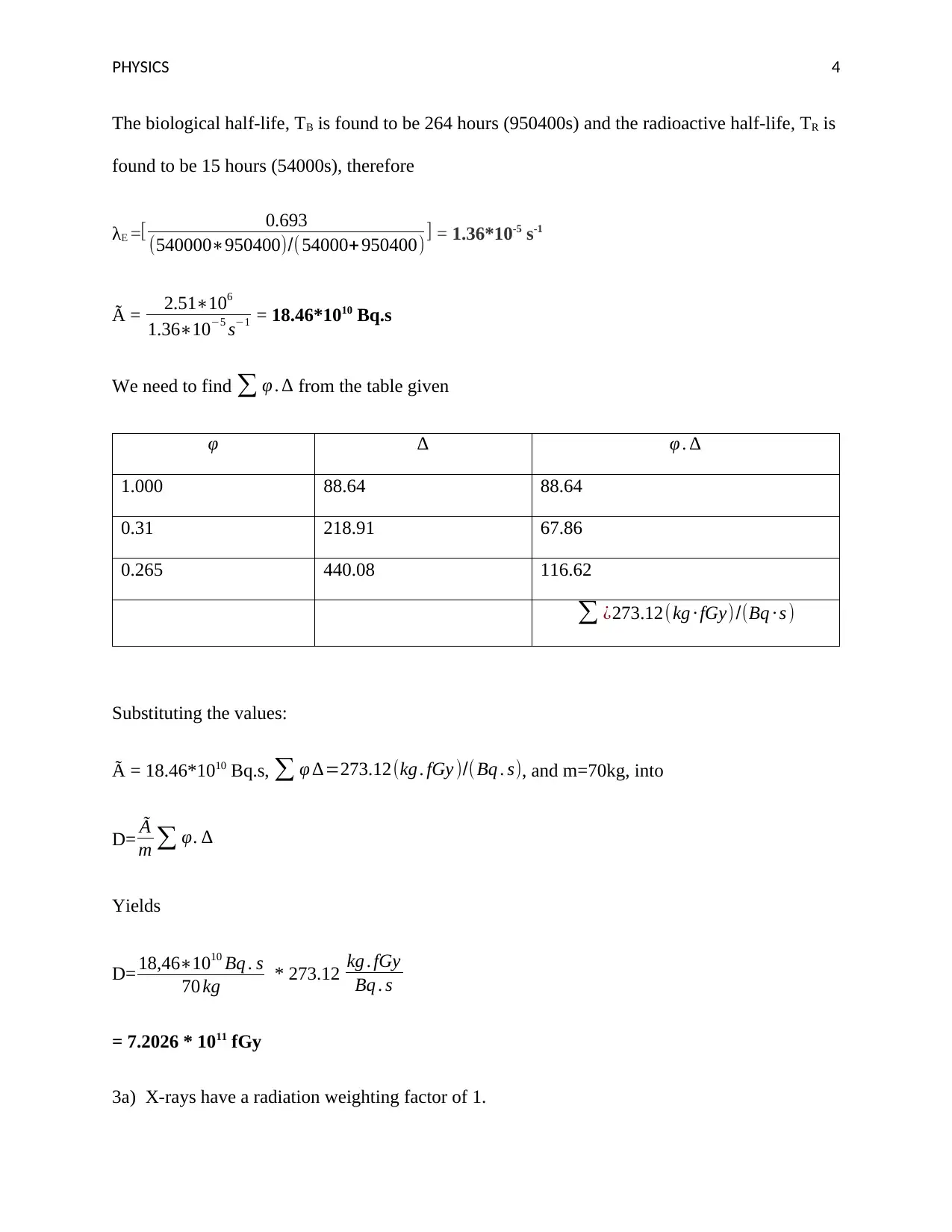
PHYSICS 4
The biological half-life, TB is found to be 264 hours (950400s) and the radioactive half-life, TR is
found to be 15 hours (54000s), therefore
λE =[ 0.693
(540000∗950400)/( 54000+ 950400)] = 1.36*10-5 s-1
à = 2.51∗106
1.36∗10−5 s−1 = 18.46*1010 Bq.s
We need to find ∑ φ . ∆ from the table given
φ ∆ φ . ∆
1.000 88.64 88.64
0.31 218.91 67.86
0.265 440.08 116.62
∑ ¿273.12(kg · fGy)/(Bq · s )
Substituting the values:
à = 18.46*1010 Bq.s, ∑ φ ∆=273.12(kg . fGy )/(Bq . s), and m=70kg, into
D= Ã
m ∑ φ. ∆
Yields
D= 18,46∗1010 Bq . s
70 kg * 273.12 kg . fGy
Bq . s
= 7.2026 * 1011 fGy
3a) X-rays have a radiation weighting factor of 1.
The biological half-life, TB is found to be 264 hours (950400s) and the radioactive half-life, TR is
found to be 15 hours (54000s), therefore
λE =[ 0.693
(540000∗950400)/( 54000+ 950400)] = 1.36*10-5 s-1
à = 2.51∗106
1.36∗10−5 s−1 = 18.46*1010 Bq.s
We need to find ∑ φ . ∆ from the table given
φ ∆ φ . ∆
1.000 88.64 88.64
0.31 218.91 67.86
0.265 440.08 116.62
∑ ¿273.12(kg · fGy)/(Bq · s )
Substituting the values:
à = 18.46*1010 Bq.s, ∑ φ ∆=273.12(kg . fGy )/(Bq . s), and m=70kg, into
D= Ã
m ∑ φ. ∆
Yields
D= 18,46∗1010 Bq . s
70 kg * 273.12 kg . fGy
Bq . s
= 7.2026 * 1011 fGy
3a) X-rays have a radiation weighting factor of 1.
Paraphrase This Document
Need a fresh take? Get an instant paraphrase of this document with our AI Paraphraser
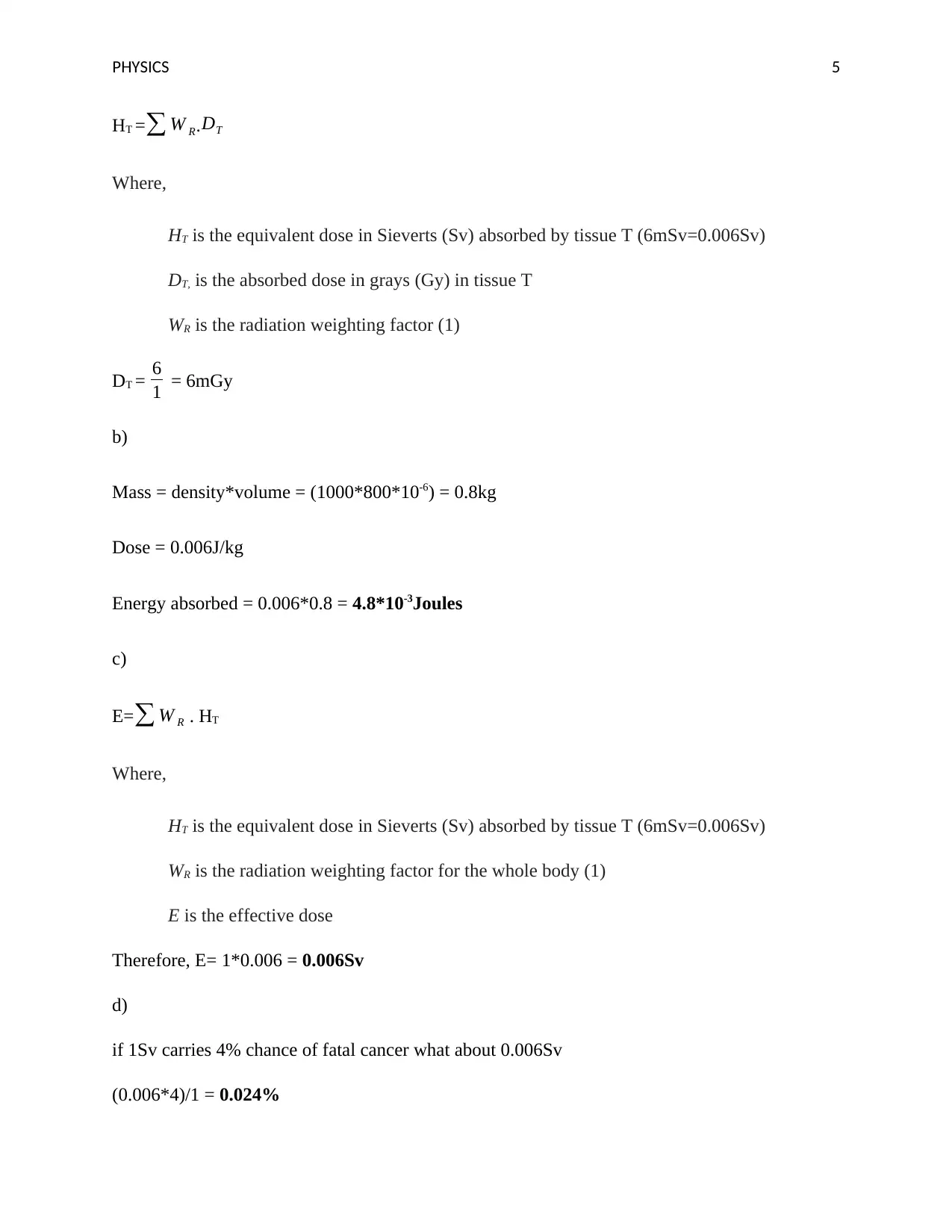
PHYSICS 5
HT =∑ W R.DT
Where,
HT is the equivalent dose in Sieverts (Sv) absorbed by tissue T (6mSv=0.006Sv)
DT, is the absorbed dose in grays (Gy) in tissue T
WR is the radiation weighting factor (1)
DT = 6
1 = 6mGy
b)
Mass = density*volume = (1000*800*10-6) = 0.8kg
Dose = 0.006J/kg
Energy absorbed = 0.006*0.8 = 4.8*10-3Joules
c)
E=∑ W R . HT
Where,
HT is the equivalent dose in Sieverts (Sv) absorbed by tissue T (6mSv=0.006Sv)
WR is the radiation weighting factor for the whole body (1)
E is the effective dose
Therefore, E= 1*0.006 = 0.006Sv
d)
if 1Sv carries 4% chance of fatal cancer what about 0.006Sv
(0.006*4)/1 = 0.024%
HT =∑ W R.DT
Where,
HT is the equivalent dose in Sieverts (Sv) absorbed by tissue T (6mSv=0.006Sv)
DT, is the absorbed dose in grays (Gy) in tissue T
WR is the radiation weighting factor (1)
DT = 6
1 = 6mGy
b)
Mass = density*volume = (1000*800*10-6) = 0.8kg
Dose = 0.006J/kg
Energy absorbed = 0.006*0.8 = 4.8*10-3Joules
c)
E=∑ W R . HT
Where,
HT is the equivalent dose in Sieverts (Sv) absorbed by tissue T (6mSv=0.006Sv)
WR is the radiation weighting factor for the whole body (1)
E is the effective dose
Therefore, E= 1*0.006 = 0.006Sv
d)
if 1Sv carries 4% chance of fatal cancer what about 0.006Sv
(0.006*4)/1 = 0.024%
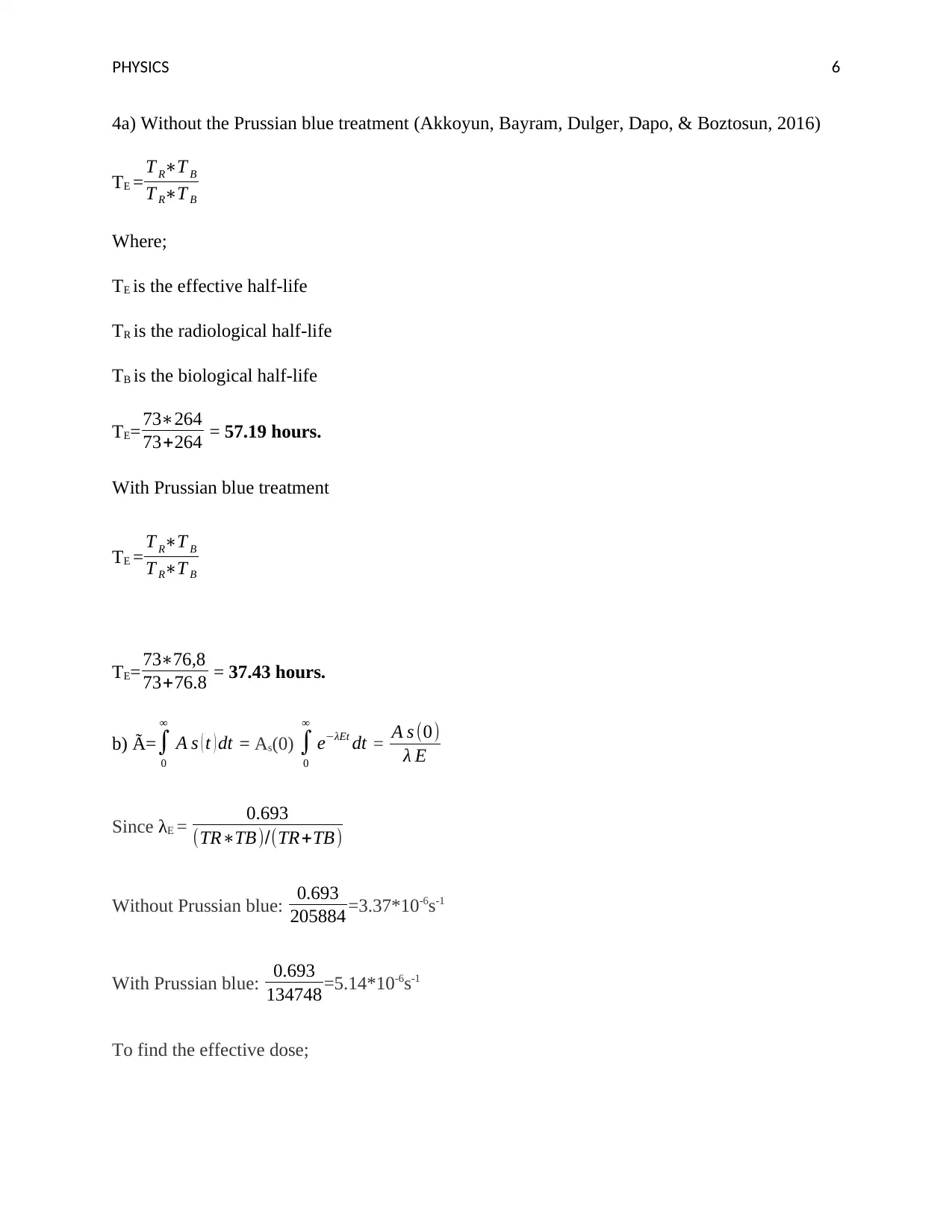
PHYSICS 6
4a) Without the Prussian blue treatment (Akkoyun, Bayram, Dulger, Dapo, & Boztosun, 2016)
TE = T R∗T B
T R∗T B
Where;
TE is the effective half-life
TR is the radiological half-life
TB is the biological half-life
TE= 73∗264
73+264 = 57.19 hours.
With Prussian blue treatment
TE = T R∗T B
T R∗T B
TE= 73∗76,8
73+76.8 = 37.43 hours.
b) Ã= ∫
0
∞
A s ( t ) dt = As(0) ∫
0
∞
e−λEt dt = A s (0)
λ E
Since λE = 0.693
(TR∗TB)/(TR+TB)
Without Prussian blue: 0.693
205884 =3.37*10-6s-1
With Prussian blue: 0.693
134748=5.14*10-6s-1
To find the effective dose;
4a) Without the Prussian blue treatment (Akkoyun, Bayram, Dulger, Dapo, & Boztosun, 2016)
TE = T R∗T B
T R∗T B
Where;
TE is the effective half-life
TR is the radiological half-life
TB is the biological half-life
TE= 73∗264
73+264 = 57.19 hours.
With Prussian blue treatment
TE = T R∗T B
T R∗T B
TE= 73∗76,8
73+76.8 = 37.43 hours.
b) Ã= ∫
0
∞
A s ( t ) dt = As(0) ∫
0
∞
e−λEt dt = A s (0)
λ E
Since λE = 0.693
(TR∗TB)/(TR+TB)
Without Prussian blue: 0.693
205884 =3.37*10-6s-1
With Prussian blue: 0.693
134748=5.14*10-6s-1
To find the effective dose;
⊘ This is a preview!⊘
Do you want full access?
Subscribe today to unlock all pages.

Trusted by 1+ million students worldwide

PHYSICS 7
3.37∗10−6∗101
5.14∗10−6 = 6.55mSv
c) Using the inverse square law;
intensity 1
intensity 2 = distance 22
distance 12
Intensity 1 (distance 1)2 = intensity 2(distance 2)2
50(12) = 5(y2)
Therefore y2 = 10
And hence y = 3.16m
Assumption: The radioactive material is assumed to be evenly radiated outward from a point
source.
d)
According to Radiation Control Regulation 2003, an accident is to be reported if there is an
administration of a radioactive substance in a quantity of more than 50% more than the
prescribed. In our case 40% should not be reported since the lethalness percentage cannot kill
half of the population exposed (Mekikis, Antonopoulos, Kartsakli, Alonso, & Verikoukis, 2017).
3.37∗10−6∗101
5.14∗10−6 = 6.55mSv
c) Using the inverse square law;
intensity 1
intensity 2 = distance 22
distance 12
Intensity 1 (distance 1)2 = intensity 2(distance 2)2
50(12) = 5(y2)
Therefore y2 = 10
And hence y = 3.16m
Assumption: The radioactive material is assumed to be evenly radiated outward from a point
source.
d)
According to Radiation Control Regulation 2003, an accident is to be reported if there is an
administration of a radioactive substance in a quantity of more than 50% more than the
prescribed. In our case 40% should not be reported since the lethalness percentage cannot kill
half of the population exposed (Mekikis, Antonopoulos, Kartsakli, Alonso, & Verikoukis, 2017).
Paraphrase This Document
Need a fresh take? Get an instant paraphrase of this document with our AI Paraphraser

PHYSICS 8
References
Akkoyun, S., Bayram, T., Dulger, F., Dapo, H., & Boztosun, I. (2016). Energy level and half-life
determination from photonuclear reaction on Ga Target. Internation Journal of Modern Physics.
Burns, D., & Buermann, L. (2009). Free-air ionization Chambers. Metrologia.
Mekikis, P., Antonopoulos, A., Kartsakli, E., Alonso, N., & Verikoukis, C. (2017). Stochastic Modeling of
wireless charged wearables for reliable health monitoring in hospital environment. In
Communication (ICC) , 1-6.
Wang, J., He, Q., & Kong, F. (2015). Adaptive multiscale noise turining stochastic reasonance for health
diagnosis of rolling element bearings. IEE Transactions on Instrumentation and Measurement ,
564-577.
Zhao, Z., Quan, Q., & Cai, K. (2017). A health Evaluation method of multicopters modeled by Stichastic
Hybrid system. Aerospace Sceince and Technology , 149-162.
References
Akkoyun, S., Bayram, T., Dulger, F., Dapo, H., & Boztosun, I. (2016). Energy level and half-life
determination from photonuclear reaction on Ga Target. Internation Journal of Modern Physics.
Burns, D., & Buermann, L. (2009). Free-air ionization Chambers. Metrologia.
Mekikis, P., Antonopoulos, A., Kartsakli, E., Alonso, N., & Verikoukis, C. (2017). Stochastic Modeling of
wireless charged wearables for reliable health monitoring in hospital environment. In
Communication (ICC) , 1-6.
Wang, J., He, Q., & Kong, F. (2015). Adaptive multiscale noise turining stochastic reasonance for health
diagnosis of rolling element bearings. IEE Transactions on Instrumentation and Measurement ,
564-577.
Zhao, Z., Quan, Q., & Cai, K. (2017). A health Evaluation method of multicopters modeled by Stichastic
Hybrid system. Aerospace Sceince and Technology , 149-162.
1 out of 8
Your All-in-One AI-Powered Toolkit for Academic Success.
+13062052269
info@desklib.com
Available 24*7 on WhatsApp / Email
![[object Object]](/_next/static/media/star-bottom.7253800d.svg)
Unlock your academic potential
Copyright © 2020–2025 A2Z Services. All Rights Reserved. Developed and managed by ZUCOL.